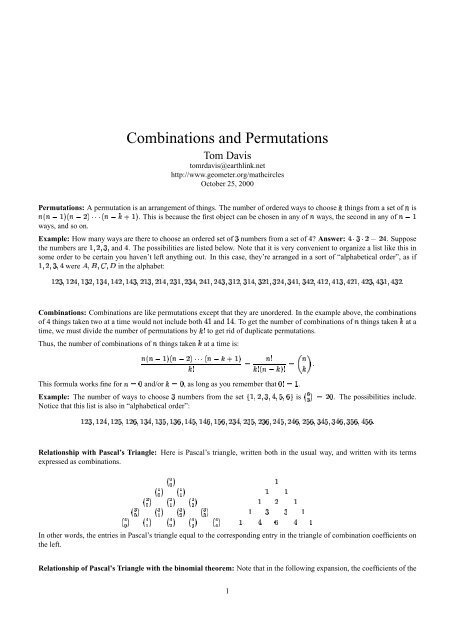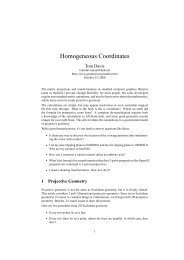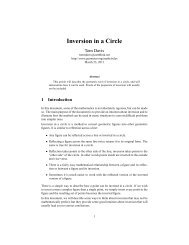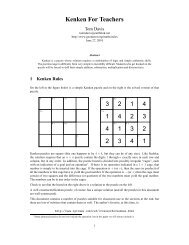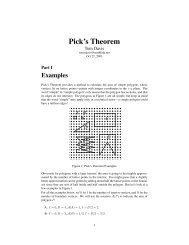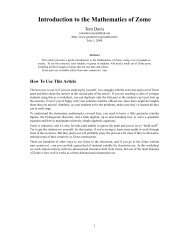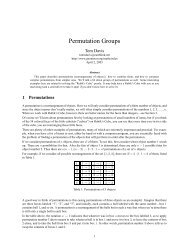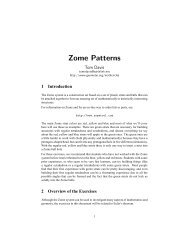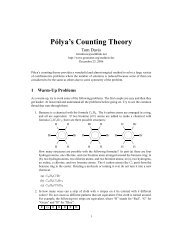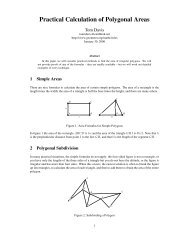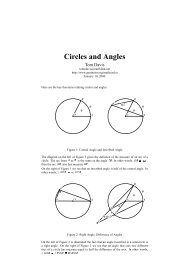Combinations and Permutations - Home Page -- Tom Davis
Combinations and Permutations - Home Page -- Tom Davis
Combinations and Permutations - Home Page -- Tom Davis
Create successful ePaper yourself
Turn your PDF publications into a flip-book with our unique Google optimized e-Paper software.
<strong>Combinations</strong> <strong>and</strong> <strong>Permutations</strong><br />
<strong>Tom</strong> <strong>Davis</strong><br />
tomrdavis@earthlink.net<br />
http://www.geometer.org/mathcircles<br />
October 25, 2000<br />
<strong>Permutations</strong>: A permutation is an arrangement of things. The number of ordered ways to choose things from a set of¡ is<br />
¨ ¢¡¥¤© ¨ ¢¡¥¤ ¦ ¨ . This is because the first object can be chosen in any of¡ ways, the second in any of¡¥¤§¦<br />
ways, <strong>and</strong> so on.<br />
¡£¢¡¥¤§¦<br />
Example: How many ways are there to choose an ordered set of numbers from a set of ? Answer: ©§© . Suppose<br />
the numbers are¦ © <strong>and</strong> . The possibilities are listed below. Note that it is very convenient to organize a list like this in<br />
some order to be certain you haven’t left anything out. In this case, they’re arranged in a sort of “alphabetical order”, as if<br />
¦ © were in the alphabet:<br />
¦ © ¦ © ¦ © ¦ ¦ © ¦ © ¦ © ¦ © ¦ © © ¦ © ¦ © ¦ © ¦ © ¦ © ¦ © ¦ © ¦ © ¦ © <br />
<strong>Combinations</strong>: <strong>Combinations</strong> are like permutations except that they are unordered. In the example above, the combinations<br />
of 4 things taken two at a time would not include both¦ <strong>and</strong>¦ . To get the number of combinations of¡ things taken at a<br />
time, we must divide the number of permutations by<br />
<br />
to get rid of duplicate permutations.<br />
Thus, the number of combinations of¡ things taken at a time is:<br />
¨ ¢¡ ¤!© ¨ ¢¡ ¤ ¦ ¨ ¡ <br />
¢¡ ¤ ¨ <br />
" ¡ # <br />
¡£¢¡¥¤¦<br />
This formula works for¡ %$ fine %$ <strong>and</strong>/or , as long as you that$<br />
&¦ remember .<br />
Example: The number of ways to choose numbers from the set' ¦ © ( ) * is +,- .¥/© $ . The possibilities include.<br />
Notice that this list is also in “alphabetical order”:<br />
¦ © ¦ © ¦ © ( ¦ © ) ¦ ¦ ( ¦ ) ¦ ( ¦ ) ¦ ( ) © © ( © ) © ( © ) © ( ) ( ) ( ) ( ) <br />
Relationship with Pascal’s Triangle: Here is Pascal’s triangle, written both in the usual way, <strong>and</strong> written with its terms<br />
expressed as combinations.<br />
+0 0 . ¦<br />
0 .2+1 1 . ¦3¦<br />
+4<br />
+1<br />
.5+41 .2+4 4 . ¦6©7¦<br />
+-<br />
0 .5+-<br />
1 .2+- 4 .8+- - . ¦639¦<br />
0<br />
0 .2+:1 .5+:4 .2+:- .8+: : . ¦;¦<br />
+:<br />
In other words, the entries in Pascal’s triangle equal to the corresponding entry in the triangle of combination coefficients on<br />
the left.<br />
Relationship of Pascal’s Triangle with the binomial theorem: Note that in the following expansion, the coefficients of the<br />
1
Gf`gG Ih^ R ` ìa GjG I RiX R I X e ` e R<br />
G<br />
But there’s also a formula. In this case, it is:<br />
P QR S§A%GVP QG S§A^£P QX S§A X P Q^ S R<br />
X<br />
L<br />
X<br />
O<br />
terms correspond exactly to the fourth row (starting at row zero) of Pascal’s Triangle:<br />
C DFE&G @ HA!I @ J B K£AL @ M B MNA!I @ K B JNA%G B H O<br />
?@AB<br />
The general expansion of a binomial to a power is given by:<br />
C QR DATP S@ UVK QX D UM B MNA%Y Y Y ATPZQ<br />
Q¥[ G S@ B D UVK\ATP Q Q<br />
SB DO<br />
?@AB DFE/P S@ QG D B£AWP S@<br />
If you’ve never done it, a good exercise is to start with, say, the expansion of <strong>and</strong> multiply that by h<strong>and</strong> by to<br />
get . You’ll then see exactly why the rule for calculating entries in Pascal’s Triangle corresponds to the combination<br />
coefficients.<br />
CH ?@AB C ?@AB J C ?@A!B<br />
Counting Tricks: If you have no idea how to proceed, it’s often a good idea to count or calculate (very carefully) the first<br />
few cases, <strong>and</strong> then try to work from that. Here’s a simple example of that, together with a new technique for analysis. The<br />
problem is to find a formula for the sum of the firstQ squares. In other words, find a formula for]<br />
?Q C<br />
, where<br />
?Q CNE&G M£A X M£A^ M£A%Y Y Y A Q M O ]<br />
In this case, it’s easy to work out the first cases:]<br />
?R C£E R<br />
,] ? G CNE_G ,] ?X C£E&G£A!IE%` ,] ?^ CNE_G£A!IAaE&G I<br />
few , <strong>and</strong> so<br />
on. Here’s a list of the first few (be sure to start your row with the forQ<br />
E R<br />
value ):<br />
Gb`_G Ic^ R ` `da GG I RcX R I X e ` R<br />
Now take differences of the numbers in this row, forming a second row. Then take differences in the second row, forming a<br />
third, <strong>and</strong> so on:<br />
L X ì^ LnI a3L I ^o`qprasG GiG ^9G `tG p<br />
GkIlamG<br />
RwR=R
‚<br />
‚<br />
‚<br />
ƒ „ … †‚‡ ‚ ‚ ‚<br />
†‚ˆ ‚ ‚ˆ ‚ ‚ ‚<br />
„ ‰ ˆ‚†‡‚ ‚† ‚ †‚†ˆ‚† ‚ ‚ ‚<br />
ƒ<br />
†‚ ‚ ‚ ‚ ‚ ‚<br />
‚ˆ†‚ ‚ †‚ˆ ‚ ‚ ‚Š ‚ ‚<br />
ƒ „ ‹ ‚‡ ‚‡ ‚‡ˆ‚ ‚† ‚‡ ‚‡Š‚ ‚<br />
ˆ‚ˆˆ‚ˆ†‚<br />
†‚‡†‚ ‚ ‚† ‚ Š‚‡ ‚ Š‚‡ ‚ †‚ ‚† ‚ ‚ Œ‚‡ ‚ ‚ ‚ ‚<br />
†‚<br />
So there are 1, 2, 5, <strong>and</strong> 14 ways to construct legal mountain chains for 1, 2, 3, <strong>and</strong> 4 pairs of the slash characters. How do<br />
we count these?<br />
The answer is<br />
‚† ‚ˆ ‚ ‡‚ ‚ ‚ ‚ ‚<br />
The way to see this is to imagine all of<br />
possible ” arrangements up-strokes <strong>and</strong> only down-strokes. From among these<br />
F F! Ž strokes, we need to choose<br />
choices. But imagine putting<br />
these stroke sequences next to each other.<br />
”%›<br />
For , look at the example “up down down up up up down”:<br />
—bš<br />
of them to be up-strokes, so there are •– — Ṽ<br />
Ž ‘ Ž n’“<br />
‚† ‚ ‚†ˆ‚ ‚<br />
‚†ˆ‚ ‚ ‚Œˆ‚ ‚<br />
‚ ‚†ˆ‚<br />
All of these will form a sort of staircase as above, <strong>and</strong> all will have a lowest point marking the lowest edge. Since the low<br />
point can occur the<br />
at<br />
Ž<br />
any<br />
<br />
of positions, we must divide by .<br />
These are known as the Catalan numbers, <strong>and</strong> they come up in many counting problems. Is it obvious why the number of<br />
valid arrangements of pairs or parentheses is also given by the Catalan numbers? For<br />
”%›<br />
:<br />
œ œ œ žœ œ œ žœ œ œ Ÿœ œ œ žœ œ œ<br />
3


